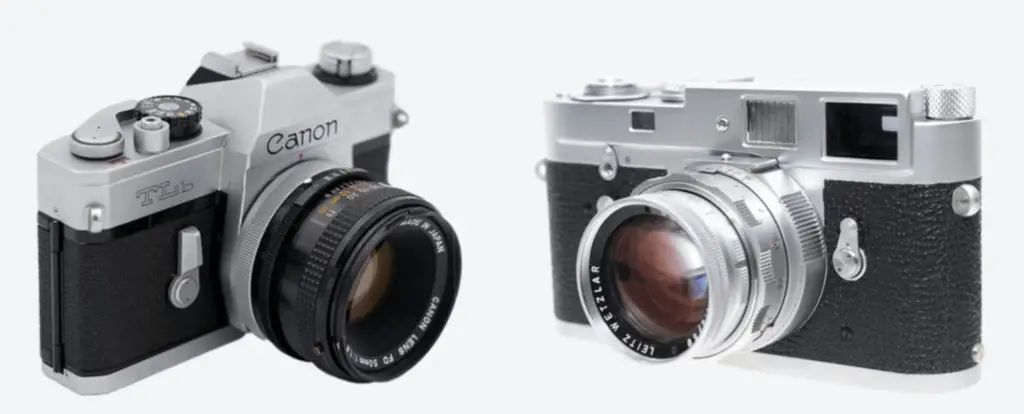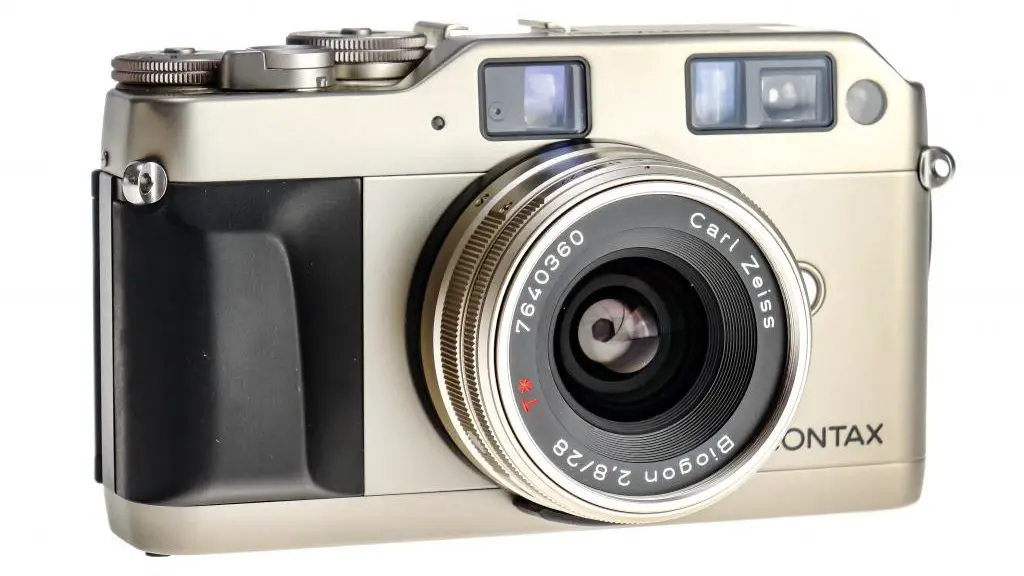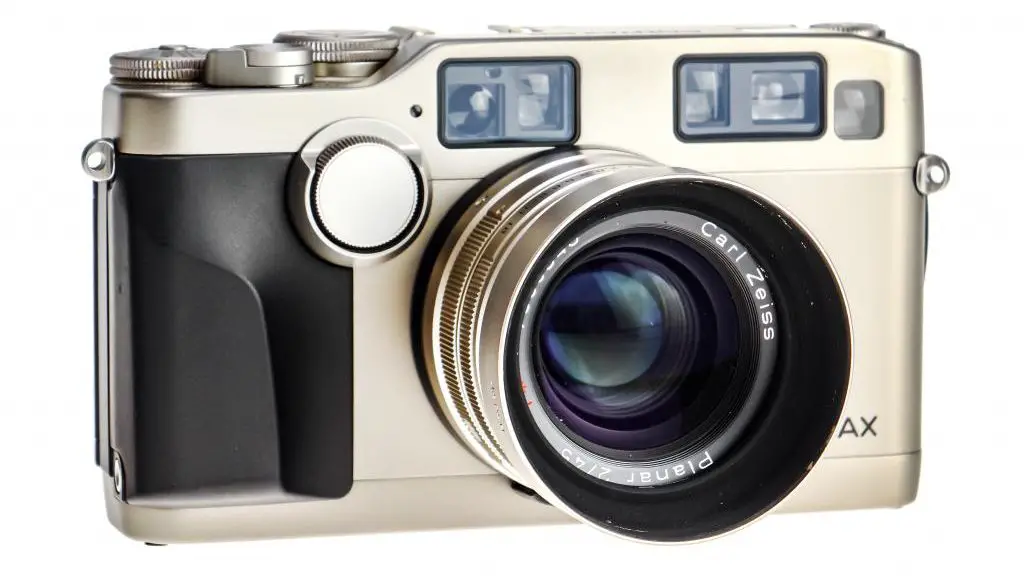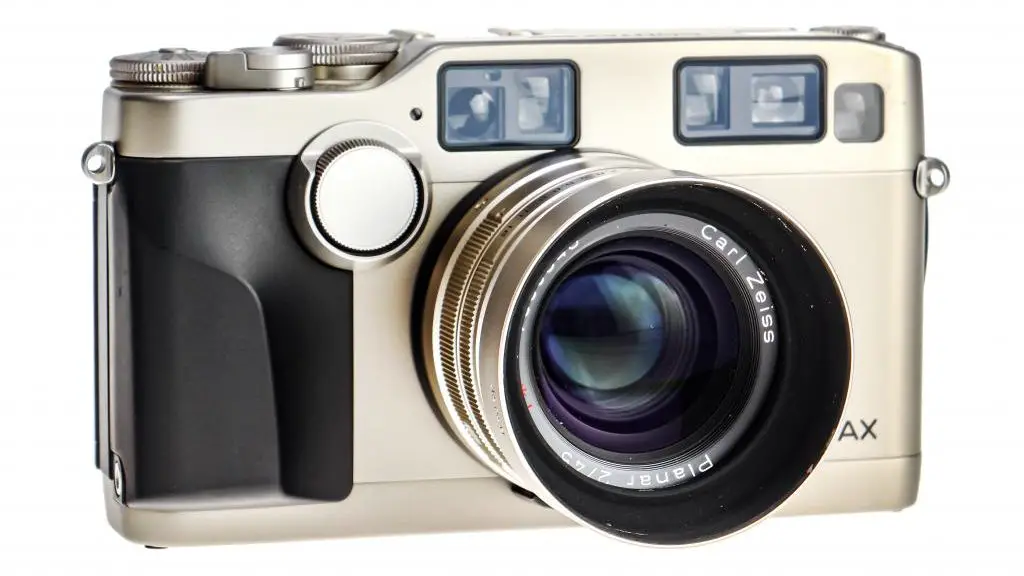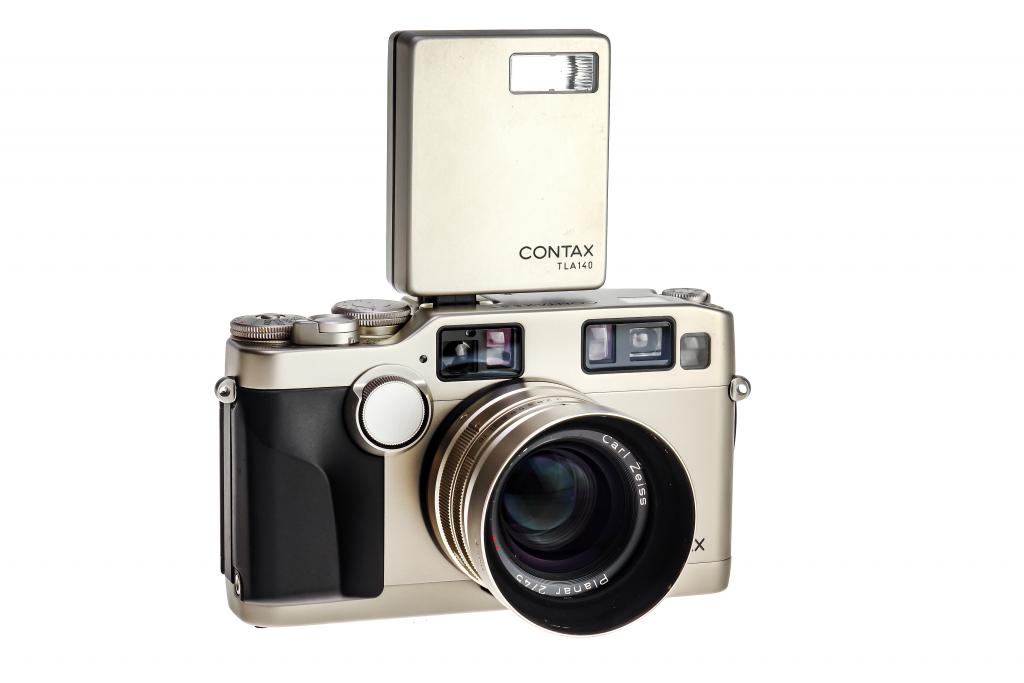Whether you are a film photography professional, enthusiast, or a beginner picking up a new hobby, the Contax G series cameras have unique features that separate them from all of the other 35mm rangefinder cameras. If you’re looking to add a new camera to your collection, you may be wondering about the differences between the Contax G1 and the Contax G2.
As a whole, the Contax G1 and Contax G2 35mm rangefinder-style film cameras are very similar. The key differences between the two cameras are the G2 has the superior autofocus system and button layout, it is slightly larger and heavier, came in more finishes, and has more lens options than the original G1.
When it comes to 35mm rangefinders, how does Contrax’s G series stack up? Are they really worth the hunt and price to own one? Read on for a Contax G1 vs. G2 comparison and everything you need to know about these two cameras.
Why Choose the Contax G Series Cameras?
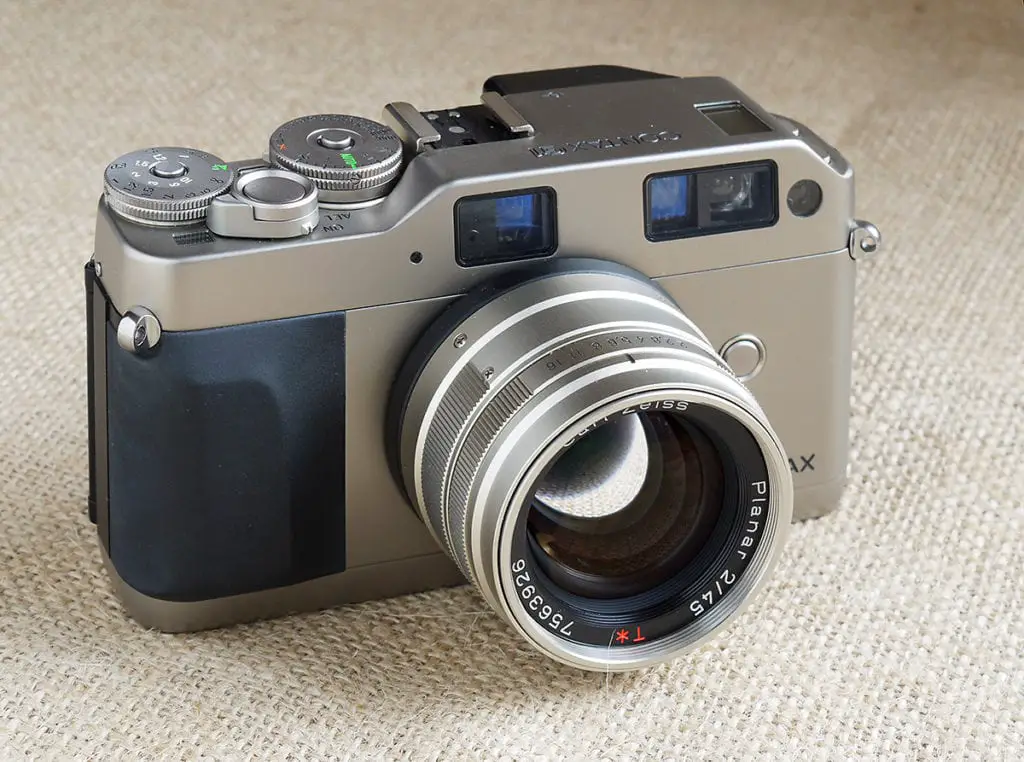
Contax G series cameras are the best option for fast and easy shooting with tack-sharp images. These Japanese-made cameras were designed to hold their own against other high-end rangefinder cameras made by Leica and Voigtlander but without the high-end price tag. They are considered the most advanced 35mm rangefinders on the market, especially when discussing the Contax G2, and use some of the best lenses ever made. These cameras have a modern viewfinder system that provides accuracy through markers on the viewfinder when shooting, along with autofocus and auto-exposure features. The viewfinder will also automatically correct for parallax error when focusing close as well as zooms in and out to compensate for whatever lens is attached. Users are also prefer the sturdy, sleek, and brick-like feel of these cameras.
are the best option for fast and easy shooting with tack-sharp images. These Japanese-made cameras were designed to hold their own against other high-end rangefinder cameras made by Leica and Voigtlander but without the high-end price tag. They are considered the most advanced 35mm rangefinders on the market, especially when discussing the Contax G2, and use some of the best lenses ever made. These cameras have a modern viewfinder system that provides accuracy through markers on the viewfinder when shooting, along with autofocus and auto-exposure features. The viewfinder will also automatically correct for parallax error when focusing close as well as zooms in and out to compensate for whatever lens is attached. Users are also prefer the sturdy, sleek, and brick-like feel of these cameras.
What is a Rangefinder Camera?
According to Ken Rockwell, rangefinder style cameras were the most popular cameras in the 1950s , with only a few still holding popularity today. These cameras tend to have higher image quality than SLRs (Single Lens Reflex cameras or what you think of when you think of a film camera) with little to no shutter lag. They are usually much smaller and lighter and feature a more quiet shutter noise, making them easier to carry around because of how they focus and how light enters the camera.
, with only a few still holding popularity today. These cameras tend to have higher image quality than SLRs (Single Lens Reflex cameras or what you think of when you think of a film camera) with little to no shutter lag. They are usually much smaller and lighter and feature a more quiet shutter noise, making them easier to carry around because of how they focus and how light enters the camera. This also makes them less conspicuous than the larger bodies of the SLRs and medium format cameras.
This also makes them less conspicuous than the larger bodies of the SLRs and medium format cameras.
Read this article for more information on the key differences between SLRs and rangefinder style cameras and why one might be a better fit for you.
on the key differences between SLRs and rangefinder style cameras and why one might be a better fit for you.
Contax G1 Cameras Use Fast, Sharp Lenses
Contax G series cameras use German-made Carl Zeiss lenses. These lenses are touted by photographers for their all metal, sturdy construction with neutral but exact colors reproduction. The lenses are made with high precision high-end glass, producing sharp images with exceptional contrast with little to no chromatic aberration , also known as color fringing, which is noticeable with the naked eye with older or cheaply made lenses.
, also known as color fringing, which is noticeable with the naked eye with older or cheaply made lenses.
Users also note that there is no noticeable light fall-off while shooting, even when the lenses aperture is open all of the way (for example, f/2 or f/2.8). This is something that can happen even with low, middle, and high-end lenses from competing lens makers (for example, Canon, Nikon, Fuji, among others) with wide angle lenses and zoom lenses being especially prone. Also, the lens coating process used in Zeiss lenses helps to create exact color reproduction with excellent light transmission (so lenses can be used in low light) and little lens or color distortion.
that there is no noticeable light fall-off while shooting, even when the lenses aperture is open all of the way (for example, f/2 or f/2.8). This is something that can happen even with low, middle, and high-end lenses from competing lens makers (for example, Canon, Nikon, Fuji, among others) with wide angle lenses and zoom lenses being especially prone. Also, the lens coating process used in Zeiss lenses helps to create exact color reproduction with excellent light transmission (so lenses can be used in low light) and little lens or color distortion.
The G-series lenses consist of seven interchangeable lenses:
About The Contax G1
Developed in 1994, the Contax G1 is an autofocusing rangefinder that was unlike anything else on the market at the time. With a fully electronic autofocus system, it is an option for those looking for the familiar feel of a manual focus rangefinder with the convenience of the autofocus features that came in an SLR camera.
is an autofocusing rangefinder that was unlike anything else on the market at the time. With a fully electronic autofocus system, it is an option for those looking for the familiar feel of a manual focus rangefinder with the convenience of the autofocus features that came in an SLR camera.
What is the Price of a Contax G1 Camera?
How much you pay for a G1 is really going to depend on the condition it is in and the seller you’re buying it from. The price can range from around $200 for the body only and up to $1200 with a lens.
only and up to $1200 with a lens.
Is Contax G1 Manual?
Essentially, the Contax G1 is an automatic 35mm film camera , but it has the capability to be used with manual settings. That being said, many users prefer to use it in its automatically setting, as its manual capability is considered subpar to other manual cameras like the Leica M series (specifically the Leica M6
, but it has the capability to be used with manual settings. That being said, many users prefer to use it in its automatically setting, as its manual capability is considered subpar to other manual cameras like the Leica M series (specifically the Leica M6 ).
).
Lenses That Can Be Used with Contax G1
Out of the seven interchangeable lenses that are compatible with the G series, only four could be used on the original G1:
What is the Green Label?
If you’ve looked into purchasing a Contax G1, you may have seen mention of acquiring a green label Contax
 G1
G1 . The “green label” G1 is a later or modified version of the camera, usually indicated by a green sticker placed where the film canister is inserted.
. The “green label” G1 is a later or modified version of the camera, usually indicated by a green sticker placed where the film canister is inserted.
These later green label G1 cameras are compatible with the 21mm f/2.8 Biogon and 35mm f/2 Planar. Even in the modified version, the 35-70mm f/3.5-5.6 Vario Sonnar still isn’t capable of connecting to the G1 due to the camera having only five electrical contacts instead of the seven that the lens requires.
What Film Does Contax G1 Use?
Contax G1 can use all types of 35mm film. Some popular 35mm films are:
- Kodak Portra 400 (color negative film – 36 exposures per roll – ISO 400)
- Kodak Ektar 100 (color negative film – 36 exposures per roll – ISO 100)
- Fujifilm Fujicolor Pro 400H (color negative film – 36 exposures per roll – ISO 400)
- Ilford hp5 plus (black and white negative film – 36 exposures per roll – ISO 400)
- Kodak TX 400 (black and white negative film – 36 exposures per roll – ISO 400)
- Kodak Ektachrome E100 (color transparency film – 36 exposures per roll – ISO 100)
For information about how to develop different 35mm films, see this article about color film and this article about black and white
and this article about black and white film.
film.
What Battery Does The Contax G1 Take?
Contax G1 uses two CR2 3V Lithium Batteries and has a low battery indicator the appears on the display screen when it is time to replace the batteries with new ones. The battery should last around 80 rolls of 24 images per roll 35mm film. I recommend carrying a spare set of batteries with you when shooting, especially if you’re going on a long trip since these types of batteries aren’t common.
How To Use The Contax G1
The Contax G1 is known for being easy to use. Still, it’s smart to familiarize yourself with the basic functions so you are confident that you’re operating your camera correctly and getting the most out of it.
How to Focus The Contax G1
The lens of the Contax G1 can be focused in two ways: automatically and manually.
Autofocus
To set your camera to autofocus, turn the dial at the top of the camera to the “AF” setting. The focus will display in the viewfinder, and the display screen will show “AF” in place of the ISO number.
When taking a photo, aim the camera at your subject and press the shutter release button halfway. The lens will automatically adjust itself to bring your subject in focus. Once you press the shutter release button all the way, the camera will take the image.
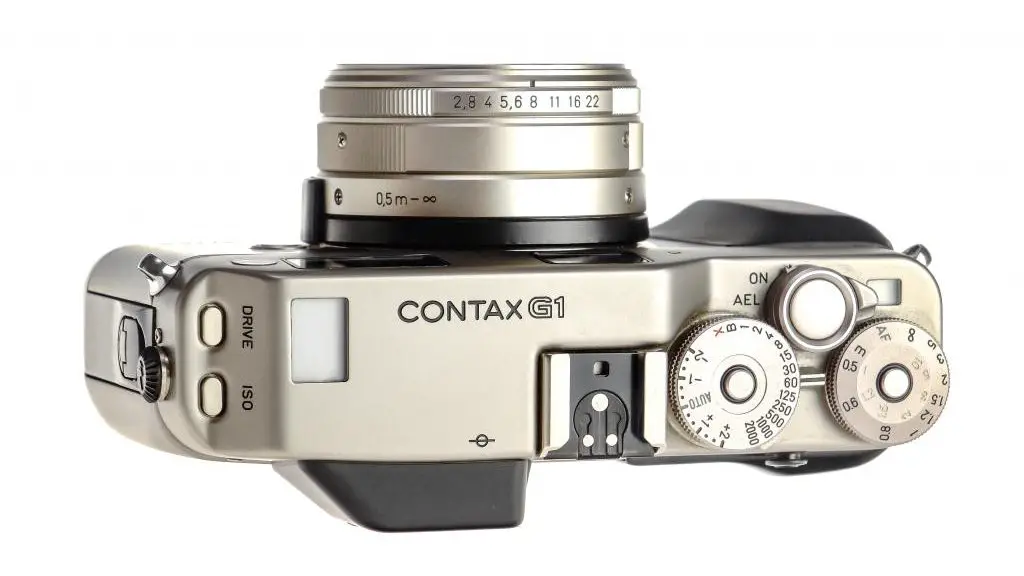
Manual Focus
To shoot using the manual setting, turn the focus dial to “0.5 m.” Just like the autofocus setting, the focus will display in the viewfinder; however, you will also see a focus scale and focus index.
To take a picture, aim the camera at the subject and turn the focus dial, which is located on the top of the camera. Keep an eye on the focus display in the viewfinder, making sure the scale lines up with the index. Once everything looks good, press the shutter release button all the way down to take the shot.
Subjects That Can Be Difficult to Focus
When trying to focus on difficult subjects, the lens may not focus the way that you intend it to. In autofocus, you can try focusing the lens on a nearby subject, pressing the shutter release button halfway, then move the camera back into the position of in your intended subject and snap the photo. You could also use manual mode to determine the shoot distance and take the picture.
Some difficult subjects to shoot include:
- Subjects that are too bright or dark
- Subjects that are in low contrast with the background
- Subjects with sharp light surrounding them
- Multiple subjects at a far distance
- Subjects that are moving at an extreme speed
- Subjects with no concrete shape (flames and smoke)
- Subjects with repeating patterns
How to Load, Unload, and Rewind Film in The Contax G1 Camera
If you’ve never touched a film camera before, loading and unloading film might seem overwhelming, but it is actually a fairly simple task in the Contax G cameras.
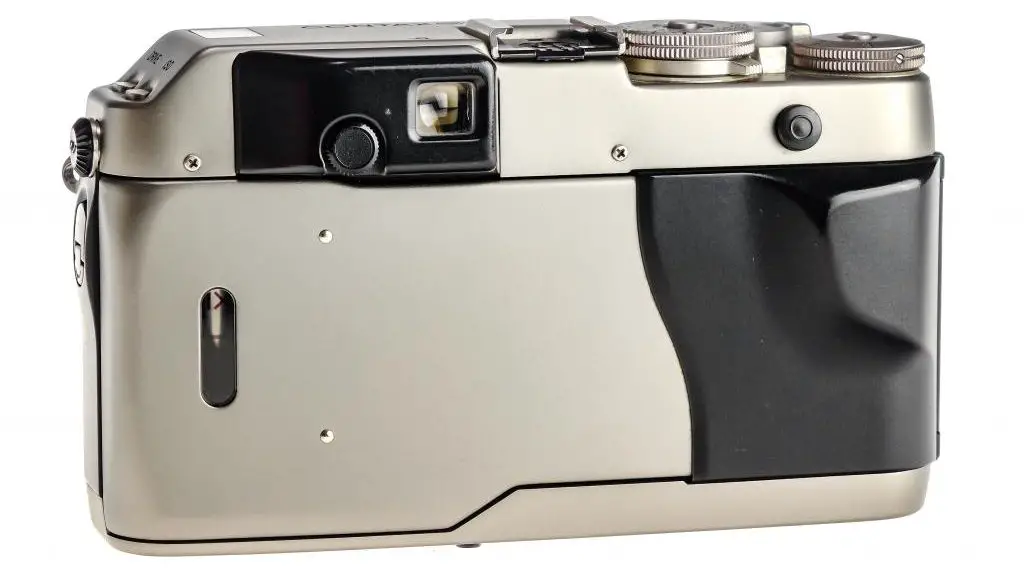
Loading Film
To load the film, follow these steps:
- First, you will need to pop open the back of the camera by lifting and rotating the release knob located on the side in the direction of the arrow.
- Remove the protective sheet in the camera’s picture area and insert the film cassette into the film chamber at a slant with the protruding end facing down.
- Pull the film tip out as far as the orange mark and place it on the spool, then close the back of the camera securely. The fill will advance automatically and stop when the exposure counter says “01.”
If you prefer to see these steps visually, there is a great video that walks you through loading a G1 here.
Rewind Film
The film will automatically rewind once the entire roll is exposed. While it is rewinding, you should see the counter counting down until it hits “00” and blinks. Once it has stopped rewinding, you can unload the film.
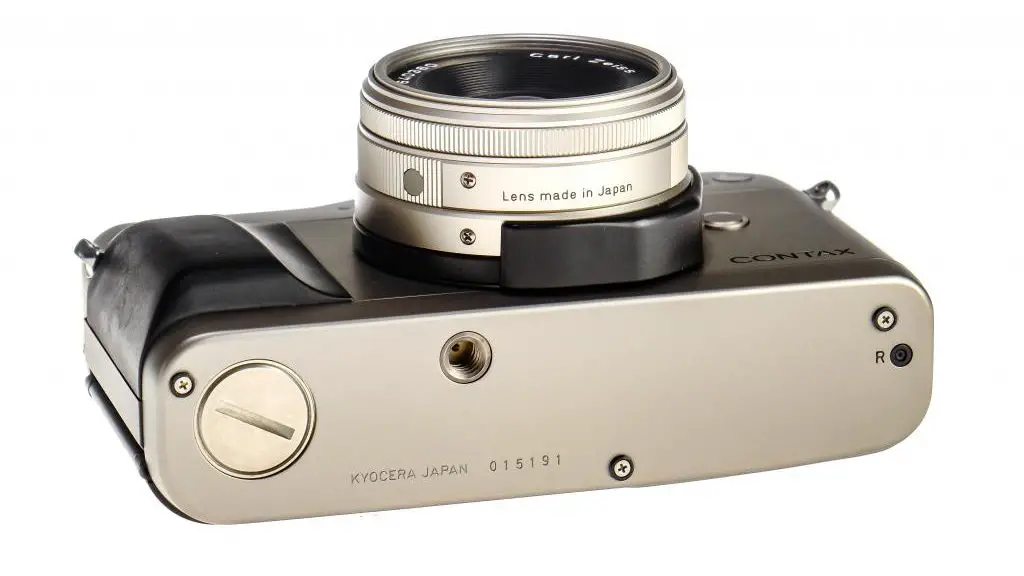
To rewind the film in the middle of a roll, you will need to press the manual rewind button located on the bottom of the camera. You will probably need to use a fine-pointed object like the end of a paper clip but avoid using anything sharp such as a needle.
Unload Film
To unload the film, make sure you are in an area with subdued light, then open the back of the camera and pull out the film canister. I recommend storing your used film in a film canister to keep it out of light before you are able to develop it. If you are interesting in learning about how to develop your own film at home see this article.
How to Change ISO on The Contax G1
To change the film speed or ISO, press and hold the ISO button on the top of the camera for about 1-2 seconds, removing your finger from the button once the ISO starts to blink on the display screen. The “drive” button will not act as an UP button, and the “ISO” button will act as a DOWN button. Use these to set your desired ISO. After 8 seconds, the ISO display will stop blinking, locking your speed in place.
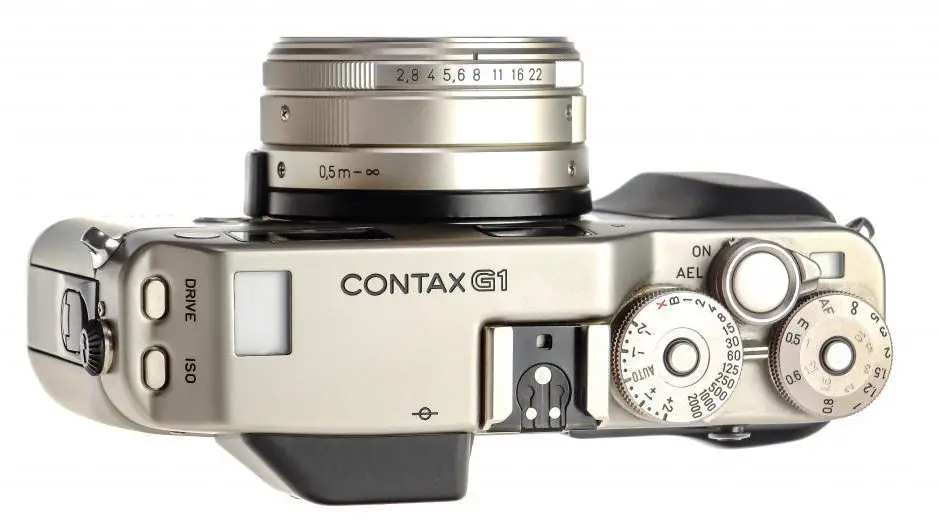
When shooting in automatic, the camera will set itself to the speed of the film you are using. If using the manual setting, you can set the film speed yourself in a range of ISO 6 to 6400.
For more information on how to use your Contax G1, you can take a look at the manual here.
About The Contax G2
The Contax G2 is often considered the world’s most advanced rangefinder camera and is recommended by many photographers as one of the best 35mm film cameras ever made. It was released in 1996, and though Contax stopped releasing cameras in 2005, it is still a very popular camera to this day.
as one of the best 35mm film cameras ever made. It was released in 1996, and though Contax stopped releasing cameras in 2005, it is still a very popular camera to this day.
What is the Average Cost of a Contax G2?
The Contax G2 is on the higher end when it comes to cost and has risen even more that in the last few years due to its popularity. The current average price is around $1400 for a body and around $2,500 with a lens, and if you’re looking for any color other than titanium, you can expect to spend even more.
You can find a used Contax G2 cameras (body only or with a lens) on Ebay here.
Is Contax G2 Manual?
Just like the G1, the G2 has the option to shoot manual. However, this isn’t often recommended. While autofocus is considered superior, many users
many users aren’t impressed with the manual settings of this camera.
aren’t impressed with the manual settings of this camera.
The manual focus is controlled by rotating a wheel on the front of the camera that is then displayed in the viewfinder using a digital scale. While this system works, compared to other rangefinder cameras and the autofocus features already in the G2, it doesn’t make sense to use it.
Lenses That Work with the Contax G2 Camera
If you’re looking for a wider range of lenses, you’ll find better luck with the G2. All seven lenses in the Contax G series work with this camera:
Including the the 35-70mm f/3.5-5.6 Vario Sonnar that wouldn’t work on the G1.
that wouldn’t work on the G1.
What Film Does The Contax G2 Camera Use?
Since the G2 is also a 35mm rangefinder like the Contax G1, it can also use the 35mm film that can be used in it. These include:
- Kodak Portra 400 (color negative film – 36 exposures per roll – ISO 400)
- Kodak Ektar 100 (color negative film – 36 exposures per roll – ISO 100)
- Fujifilm Fujicolor Pro 400H (color negative film – 36 exposures per roll – ISO 400)
- Ilford hp5 plus (black and white negative film – 36 exposures per roll – ISO 400)
- Kodak TX 400 (black and white negative film – 36 exposures per roll – ISO 400)
- Kodak Ektachrome E100 (color transparency film – 36 exposures per roll – ISO 100)
For information about how to develop different 35mm films, see this article about color film and this article about black and white
and this article about black and white film.
film.
What is DX Coded Film?
DX coding is the markings on film that tell the camera the ISO of the film and how many exposures are on the roll. DX coded film will work in any camera that supports coding, as well as those that don’t.
What Battery Does The Contax G2 Take?
Contax G2 takes two CR2 3V lithium batteries, like its predecessor. The battery should last around 80 rolls of 24 images per roll 35mm film. The battery compartment is located on the bottom of the camera and requires a coin to turn and open the compartment cover. The battery warning mark will only show on the display panel when the batteries are running low, so if you don’t see it, then there’s no need for concern.
How To Use The Contax G2
How you use a Contax G2 is pretty similar to the function of the G1, with some slight differences due to the extended features. The button layout is also slightly different, but there is nothing too noticeable. We will go over some of the basic things you need to know below. You can also take a look at the manual for the Contax G2 here.
How to Focus The Contax G2
Unlike the G1, the Contax G2 has three focus modes: Single Auto Focus (SAF), Continuous Auto Focus (CAF), and Manual Focus (MF) which can be changed by moving the small dial on the back of the camera to the corresponding setting. See the image below to see where the dial is located.
Single Auto Focus (SAF)
To shoot in Single Auto Focus, turn the Focus-Mode Dial to the SAF position. In this mode, autofocus operates when the shutter release button is pressed halfway, then pressed down all the way once the focus is locked on the subject. The shutter will not operate unless the lens is in focus to save film.
Continuous Auto Focus (CAF)
Continuous Auto Focus operates when the shutter release is pressed halfway, but instead of locking the lens in position, focusing is performed continuously, locking onto whatever subject is in the center of the viewfinder. This mode works best for shooting children or subjects that are in constant movement.
Manual Focus (MF)
In this setting, the focus is performed manually by turning the focus dial located on the front of the camera (this was added to the G2 and doesn’t exist on the G1). Once the camera is set in manual mode, you will use the focus scale in the viewfinder, rotating the focus dial until the scale is aligned with the index mark.
How to Mount the Lens on Your G2
For a camera without a lens, you first need to remove the camera’s body cap and the rear cap on the lens. If there is already a lens on the camera, remove it by holding the lens grip ring and pressing the lens release button on the face of the camera. Turn the lens counterclockwise as you pull forward until the lens releases from the camera body.
To mount the lens, align the red dot on the lens with the index mark on the camera body. Insert the lens into the body and turn it clockwise while pressing it in. You should hear a click when the lens locks into place.
When mounting and removing your lens, it’s important to make sure that you don’t touch the lens surface or the camera’s inside. Always hold the lens around the grip ring and replace the rear cap and lens cap when not used.
How to Use Flash on the Contax G2
When taking your photos indoors or at night, you will sometimes need to use a flash to light up your subject. Contax G series cameras do not come with a built in flash. However, they use the TLA Flash System, which uses direct light metering to automatically control the amount of light used through the use of a mountable flash that attaches to the hot shoe on the top of the camera. Contax made the TLA140 as well as the TLA200 flashes.
To use flash, first, mount the TLA flash unit on the hot shoe located on the top of your camera, then set the flash to “TLA AUTO MODE.” Once the flash is fully charged, you will see a flash icon appear in the viewfinder. Set your aperture to avoid overexposure, then take the picture by pressing the shutter button.
How to Load, Unload, and Rewind Film in Contax G2
Loading and unloading film in the G2 is pretty much the same process as it is in the G1 but here it is again, just in case.
Loading Film
To load the film into your camera, follow these steps:
- First, you will need to pop open the back of the camera by lifting and rotating the release knob located on the side in the direction of the arrow.
- Remove the protective sheet in the camera’s picture area and insert the film cassette into the film chamber at a slant with the protruding end facing down.
- Pull the film tip out as far as the red mark and place it on the spool, then close the back of the camera securely. The fill will advance automatically and stop when the exposure counter says “01.”
If you prefer to see these steps visually, there is a great video that walks you through loading a G2 here.
Rewind Film
The film will automatically rewind once the entire roll is exposed. While it is rewinding, you should see the counter counting down until it hits “00” and blinks. Once it has stopped rewinding, you can unload the film.
To rewind the film in the middle of a roll on the G2, you will need to press the manual rewind button located on the left-hand side of the camera when looking at the viewfinder, unlike the G1 where the rewind button is located on the bottom of the camera. You will probably need to use a fine-pointed object like the end of a paper clip but avoid using anything sharp such as a needle.
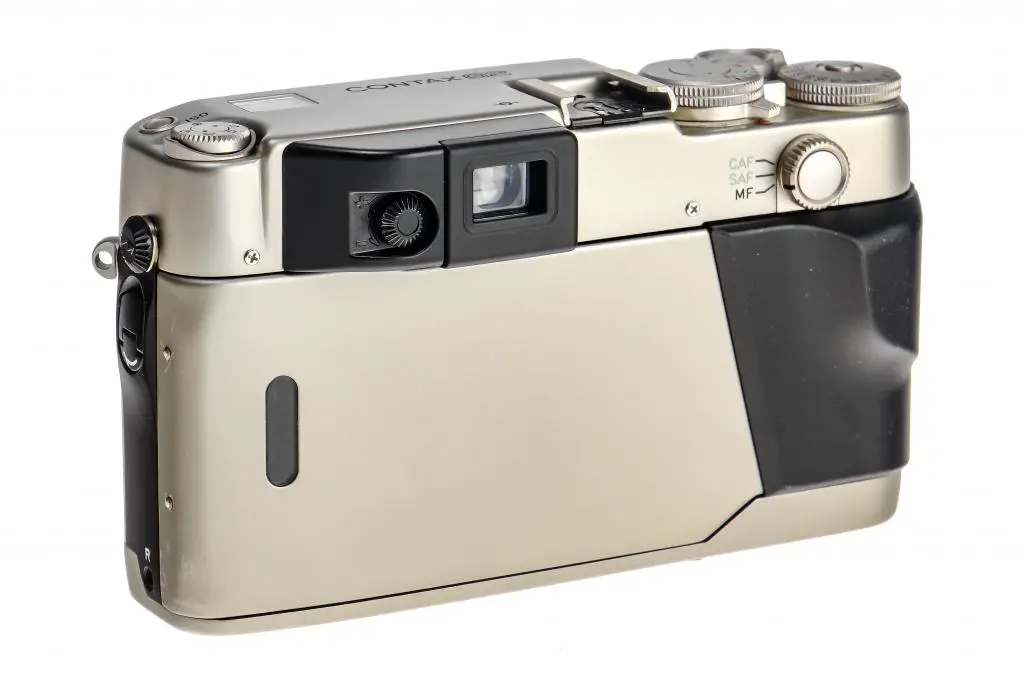
Unload Film
To unload the film, make sure you are in an area with subdued light, then open the back of the camera and pull out the film canister. I recommend storing your used film in a film canister to keep it out of light before you are able to develop it. If you are interesting in learning about how to develop your own film at home see this article.
One thing to keep in mind when loading your film is not to touch the shutter curtain with your finger or hit it with the tip of the film to avoid damaging it.
How to Change ISO on Contax G2
The ISO can be set by using the automatic setting modes or manual setting mode.
If you are using DX film and the film speed is set to “DX,” the camera will automatically set itself to the speed (or ISO) of the film you are using. You will know that camera is in automatic mode if you see “DX” on the display panel. If the camera is loaded with non-DX film, the film speed will automatically be set to ISO 100.
To set the ISO manually, switch the film speed to manual mode by holding the ISO button for about 1 to 2 seconds or until the ISO starts to blink on the display panel. Turn the focus dial to change the ISO in 1/3 increments in a range of 6 to 6400. While the ISO is being set, the display in the viewfinder will blink, and no pictures can be taken. Once you’ve chosen your speed, set the main switch to OFF to complete the process.
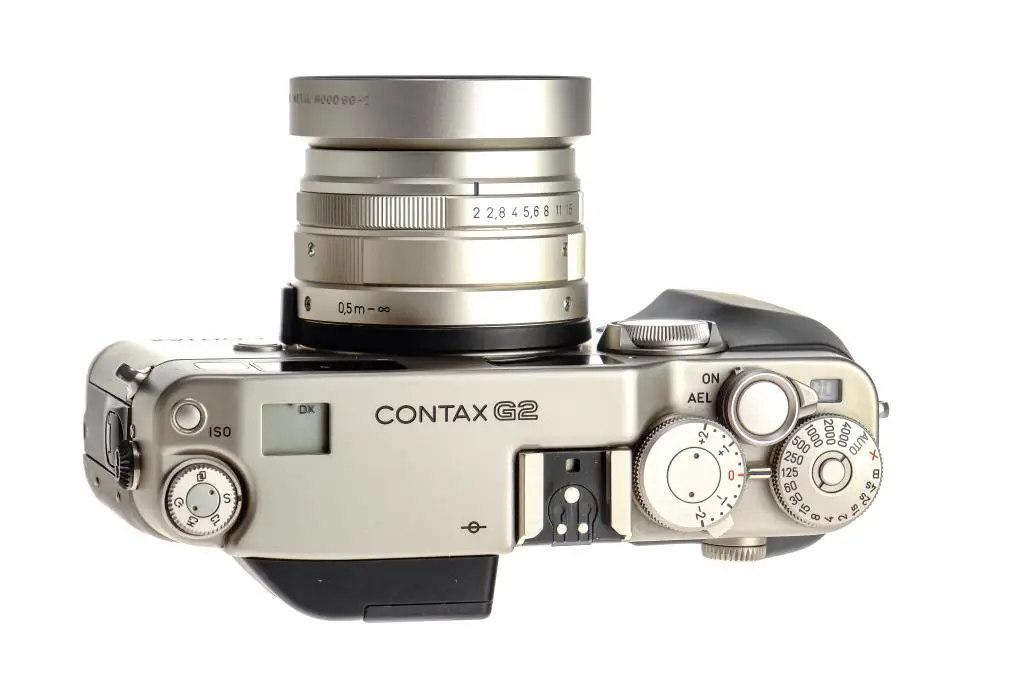
How the Contax G1 and Contax G2 Compare
The cameras in the Contax G series are loved by film camera users who have had the chance to use them. They are considered the world’s most advanced 35mm rangefinder system while being sturdy and easy to use. They are essentially point and shoot cameras because of the autofocus and as long as you have some basic understanding of photography exposure and composition, you should end up with a decent photograph.
because of the autofocus and as long as you have some basic understanding of photography exposure and composition, you should end up with a decent photograph.
When it comes to choosing between the two cameras, many users prefer the G2 over the G1 because of its superior autofocus and larger choice of compatible lenses.
the G2 over the G1 because of its superior autofocus and larger choice of compatible lenses.
Why Would You Get the G1 or G2?
Compared to the Contax G1, the G2 has improved autofocus performance . The G1 uses a phase detection system that provides accuracy in certain conditions but performs slow and lacks accuracy in low light and close-up photography. The G2, however, added an active focus system to the passive one on the G1, which uses infrared beams and triangulation for a faster, more accurate focusing. The G2 also added an additional focusing mode over the G1 – a continuous focus mode which allows the camera to continuously focus while the shutter is pressed half-way down. The single focus mode was also changed in the G2 to only allow the camera to take a picture if the image was in focus to save film.
. The G1 uses a phase detection system that provides accuracy in certain conditions but performs slow and lacks accuracy in low light and close-up photography. The G2, however, added an active focus system to the passive one on the G1, which uses infrared beams and triangulation for a faster, more accurate focusing. The G2 also added an additional focusing mode over the G1 – a continuous focus mode which allows the camera to continuously focus while the shutter is pressed half-way down. The single focus mode was also changed in the G2 to only allow the camera to take a picture if the image was in focus to save film.
Besides the change of the location of the focus dial to the front and replacing it with the shutter dial from the G1 to the G2, The G2 also changed the drive button from the G1 to a dial, rotated the LCD screen, and moved the ISO button. This drive dial lets you choose between single shot mode, double exposure mode, 2 frames per second mode (indicated with CL), 4 frames per second (indicated by CH), and a 10 second timer. Some users prefer this different location for mode dial because of easy access but most users claim the dials moves too easily in a bag and must be checked constantly before shooting. Also, notice the changes is locations of shutter speed and exposure compensation dials.
this different location for mode dial because of easy access but most users claim the dials moves too easily in a bag and must be checked constantly before shooting. Also, notice the changes is locations of shutter speed and exposure compensation dials.
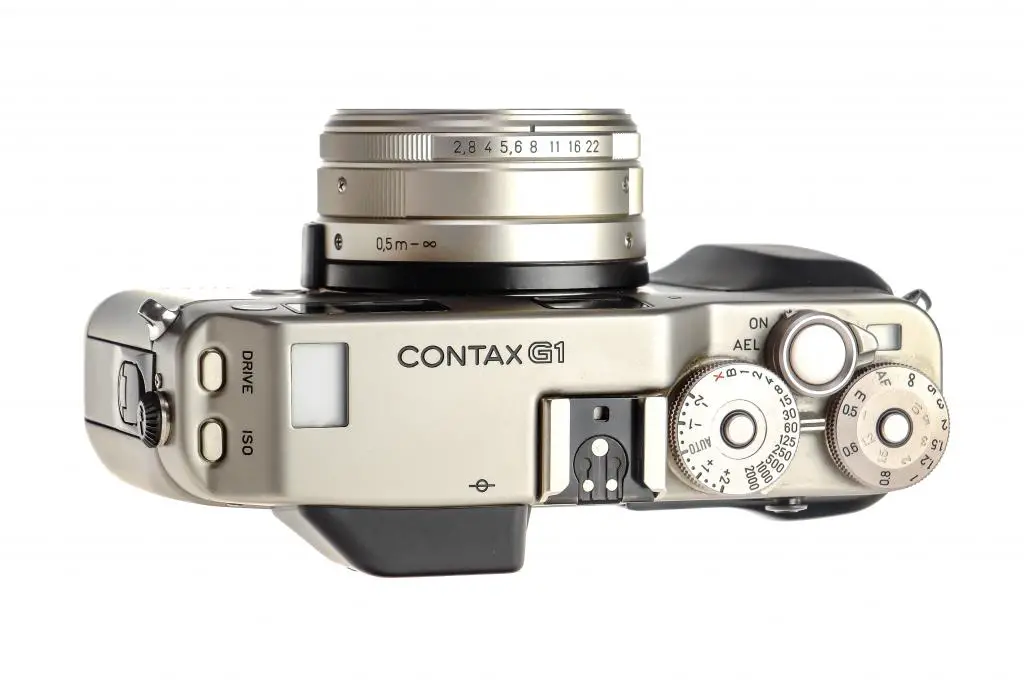

The G2 is slightly larger and heavier than the G1 (1.24 lbs for the G2, and 1.0125 for the G1) but has a similar sleek titanium body. The G2 was produced in three finishes: titanium, black paint, and black chrome as opposed to the G1 one titanium finish. However, it might be a bit too heavy for some users who may prefer the smaller and lighter G1.
Is the Contax G Series Worth It?
When it comes to using 35mm film cameras, it isn’t just about the quality of the shot but also the experience while taking the shot. The Contax G series hits both of these marks.
Both cameras have a classic, streamlined feel and quiet shutter noise. They are also easy to carry, so you can always have a camera on you without having to lug a bulky, heavy weight around your neck. Plus, all of the buttons and dials are right where they need to be, making control the camera as fast and easy as modern digital cameras.
Some camera enthusiasts claim that the Contax G cameras aren’t true rangefinders because of the electronic autofocus system, while others would disagree. They also say the viewfinders on the Contax G system are small and dark compared to other 35mm rangefinders on the market. Regardless of where they stand, all agree that using these cameras is truly a unique and worthy experience that even competes well-known high-end camera models like the Leica M6 which sell for 2-3x more, even on the used market.
claim that the Contax G cameras aren’t true rangefinders because of the electronic autofocus system, while others would disagree. They also say the viewfinders on the Contax G system are small and dark compared to other 35mm rangefinders on the market. Regardless of where they stand, all agree that using these cameras is truly a unique and worthy experience that even competes well-known high-end camera models like the Leica M6 which sell for 2-3x more, even on the used market.
Other Contax Cameras to Consider
As Contax G cameras become harder and harder to come by, you might be curious about other cameras in Contax’s lineup. Contax is a brand that dates all the way back to 1932, so they have quite a few interesting and noteworthy models to consider.
- Contax Ax: Introduced in 1996, the Contax AX
 is the only camera that can autofocus manual focus lenses. The system works like a camera within a camera
is the only camera that can autofocus manual focus lenses. The system works like a camera within a camera , using an internal/external camera body system to move the film around in the camera instead of moving the lens to focus. These cameras cost ranges between $200 and $600.
, using an internal/external camera body system to move the film around in the camera instead of moving the lens to focus. These cameras cost ranges between $200 and $600.
- Contax RTS: This is an SLR 35mm camera that was first introduced in 1975. This review
 discusses the pros and cons of using a Contax RTS, with one of the main features being its unique control setup. You can find these online, starting as low as $80 and as high as $400.
discusses the pros and cons of using a Contax RTS, with one of the main features being its unique control setup. You can find these online, starting as low as $80 and as high as $400.
- Contax T2: The Contax T2
 was released in 1990 as the second camera in the Contax T series. This is a compact camera with a retractable lens, so it can easily fit in your pocket. This review
was released in 1990 as the second camera in the Contax T series. This is a compact camera with a retractable lens, so it can easily fit in your pocket. This review talks about the pros and cons of the camera. The average price of these
talks about the pros and cons of the camera. The average price of these today on Ebay.com is between $700 and $1100
today on Ebay.com is between $700 and $1100
- Contax T3: The Contax T3
 is one of those cameras that many people think about buying but don’t because of the price. Like its predecessor, the T3 is a high-end compact 35mm and considered by many photo hobbyists as one of the finest point and shoot cameras ever made. This review
is one of those cameras that many people think about buying but don’t because of the price. Like its predecessor, the T3 is a high-end compact 35mm and considered by many photo hobbyists as one of the finest point and shoot cameras ever made. This review discusses the pros and cons of the camera. The current average price
discusses the pros and cons of the camera. The current average price on Ebay.com is between $1100 and $3000, but it might be worth considering if you’re looking for a camera that can go everywhere with you.
on Ebay.com is between $1100 and $3000, but it might be worth considering if you’re looking for a camera that can go everywhere with you.
Final Thoughts
Though both the Contax G1 and G2 are favorites among photography enthusiasts, when comparing the two, the G2 comes out on top (slightly). Both cameras in the Contax G series are superb rangefinders with a user experience that is unlike any other. In fact, both cameras are known at the anti-rangefinder because of their amazing autofocus in a rangefinder body. If you have specific requirements that you’re looking for, like more lens or a faster shutter speed, then get the G2. Otherwise, the Contax G1 works well in most situations and costs less.
Sources:

